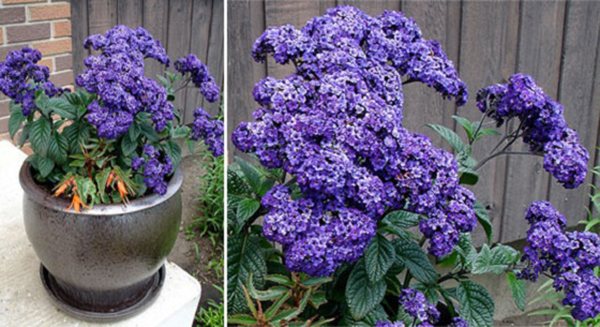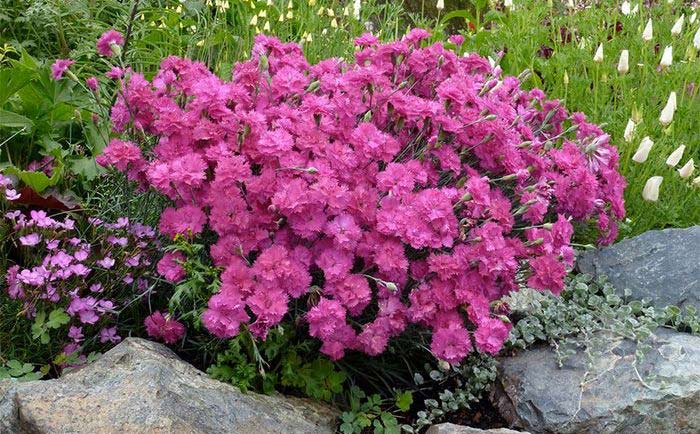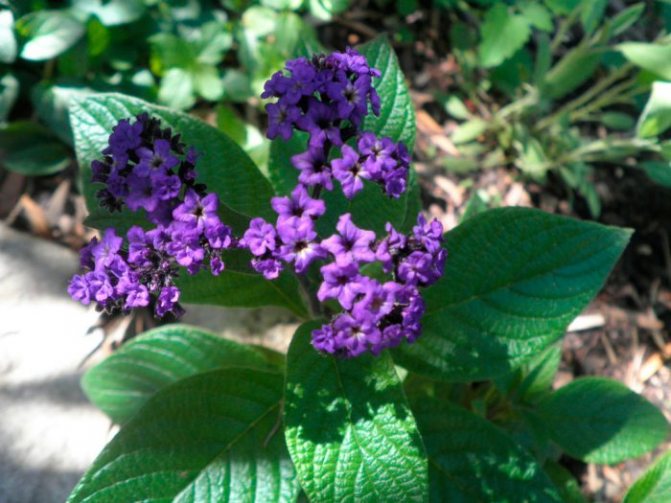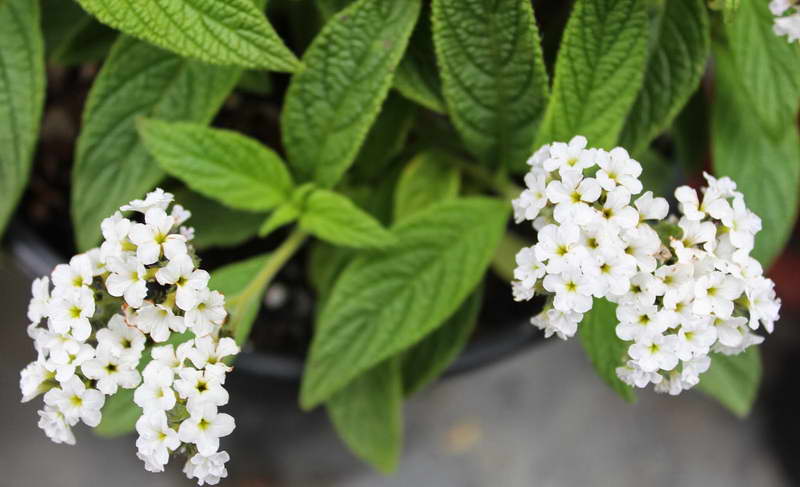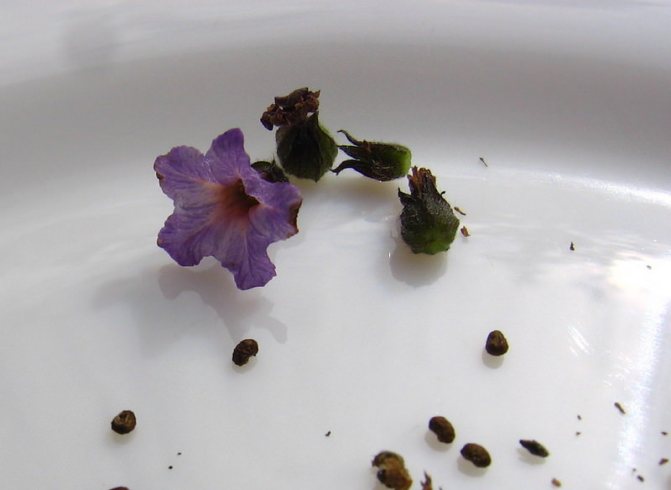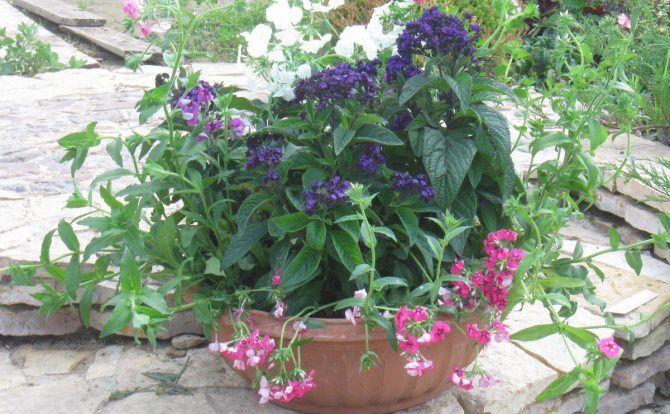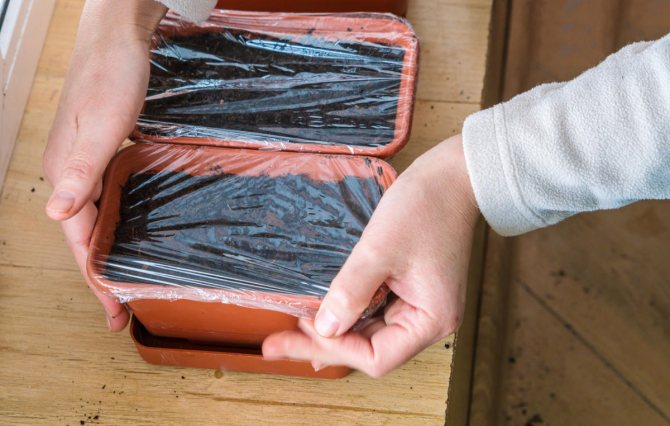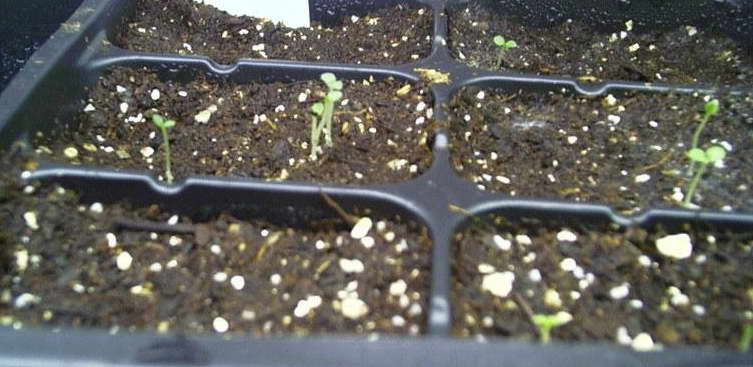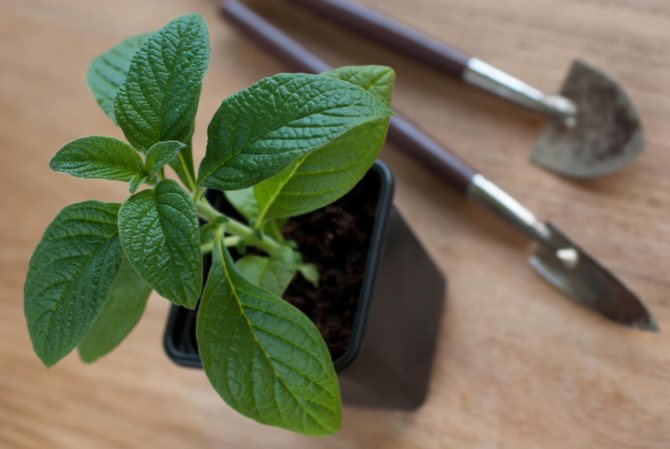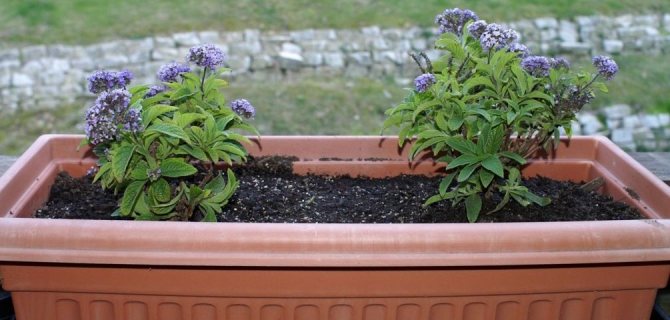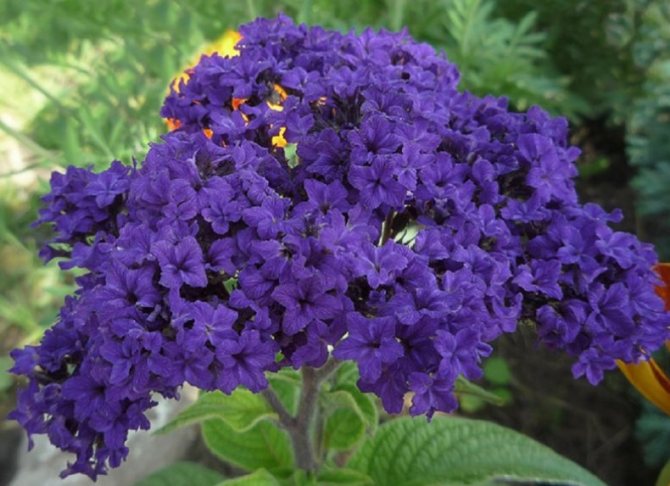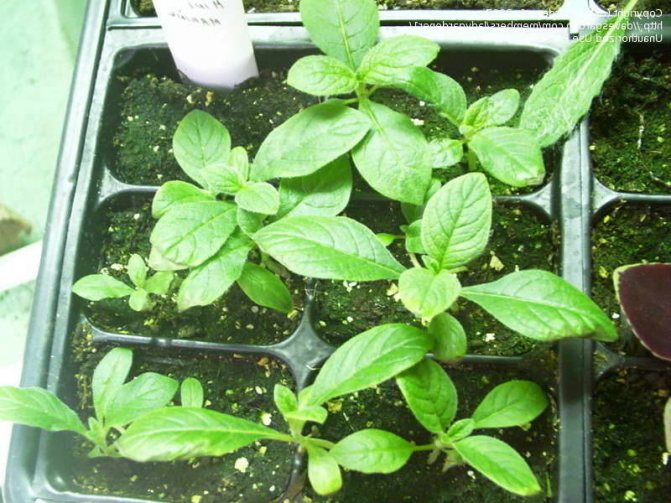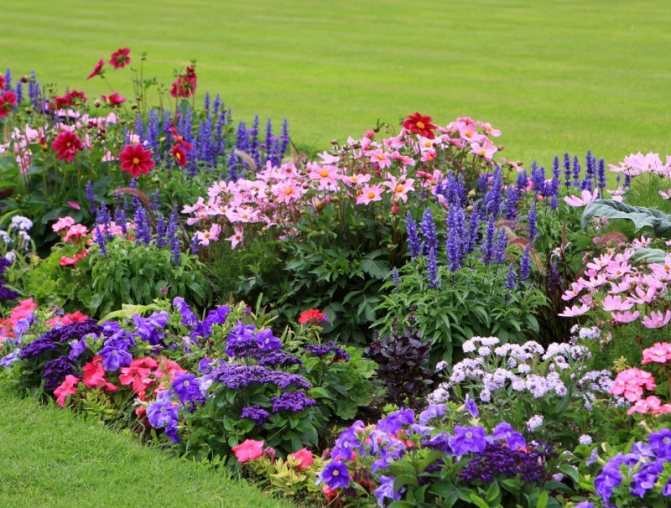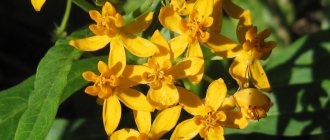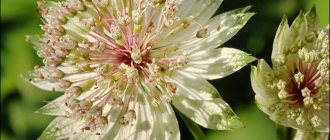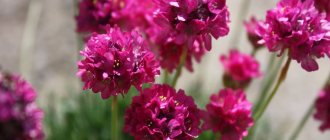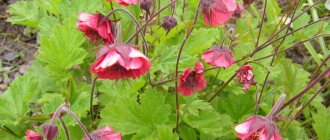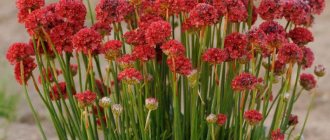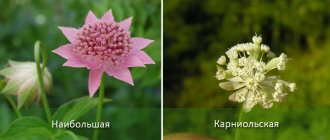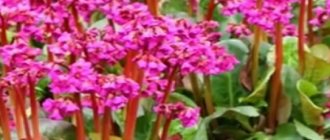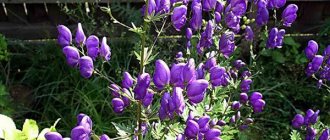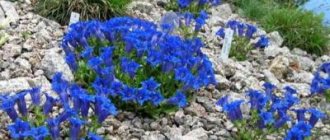"Grass of God", "Cherry Pie", "Grass of Love", "Litmus Dyeing", "Peruvian Sunflower" - all these are the names of the same strikingly attractive annual flower that came to us from the distant 17th century. Its official name comes from two Greek words "sun" and "turn, rotation" - Heliotrope, which he was awarded for the manner of turning the inflorescence after the Luminary.
The plant gained popularity among flower growers for its extraordinary aroma and original shades of inflorescences. But heliotrope is popular not only among flower growers, but also in perfumery and medicine. In addition, he is credited with magical powers, believing that he is able to protect the owner from all sorts of misfortunes. According to legend, he can contribute to success in all endeavors, gaining harmony with oneself, others and nature.
Some features of the flower
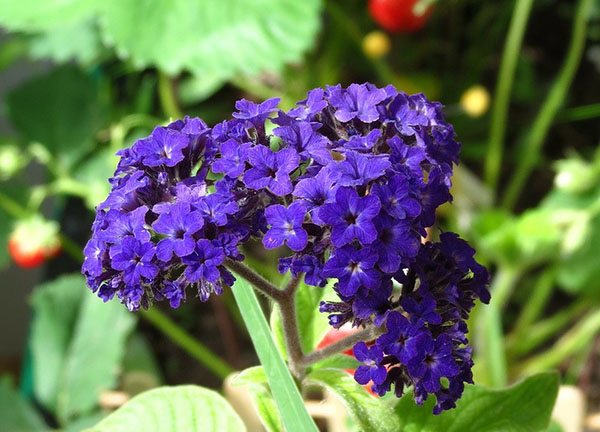
Breeders have bred about 300 species of this crop. In temperate latitudes (with frosty winters), only annuals are grown, although many acquire perennial varieties for home conditions.
You can add splendor to the bush and flowering with the help of mineral fertilizers. Top dressing is applied every 14 days until the first bud ovaries appear.
The flowering period lasts more than one month, starting in July (depending on the area) and ending with the first drop in temperature. This representative of the Buryachnikov family grows exclusively in open areas that are sufficiently warmed up by the sun. The name of the heliotrope flower comes from 2 Latin words: "to turn" and "sun". They aptly describe the nature of the plant. Outwardly, this prim bush has the following features:
- Leaves. The color is dark green and the shape resembles a small upside-down boat. Due to the symmetrically located veins, the leaves have a relief structure. On the stem, they are staggered and planted on small petioles.
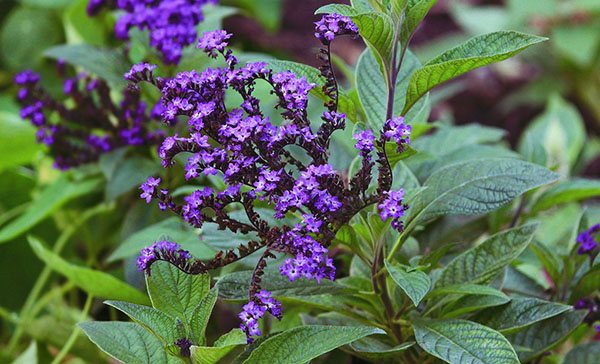

- Flowers. One shield accommodates dozens of small flowers. The diameter of such a bloom is about 25 cm. The peduncle is long and straight. They are mostly done by the Great Artist in dark blue and purple tones. However, there are examples of a white shade (White Lady), as well as with a yellow / brownish center (Kurasovsky).
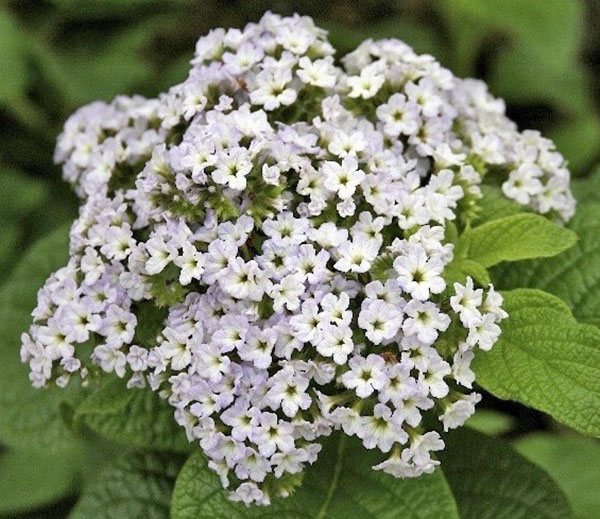

- Fruit. When they ripen, they break into four slices. If they are collected in time, then they are suitable for planting heliotrope next year. It should be borne in mind that in the northern regions the seeds do not have time to ripen, therefore they do not germinate well, and their flowers are small and poor.
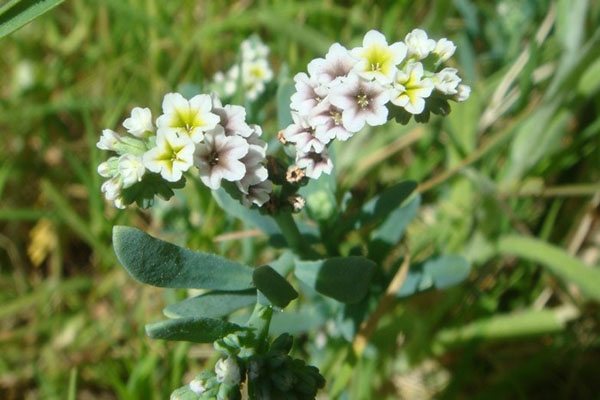

The shrub should be planted on the sunny side of the personal plot. The land should be rich in humus and shallow groundwater. You need to water the flower bed often, but make sure that the water does not stagnate. Moreover, in order for the culture to develop successfully, it needs to pinch the shoots, the tops. After all, some varieties reach 30-60 cm in height.
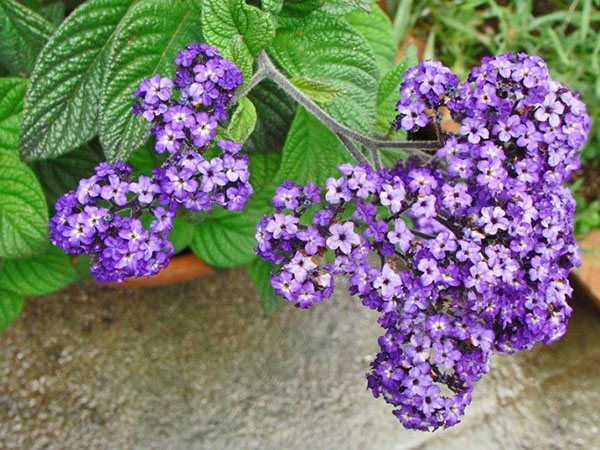

Weeds can drown out the root system, so it is important to weed the soil regularly. To prevent the soil from drying out in the hot summer, you can make mulch from leaves and grass.
Description of the plant
The heliotrope plant (Heliotropium) is represented by different species, among which there are shrubs, semi-shrubs, herbaceous representatives.The herbaceous flower heliotrope is perennial in nature, in hot countries, it can grow in one place for a long time. In our climatic zone, it is grown as an annual. Its root system does not withstand low temperatures, it freezes quickly.
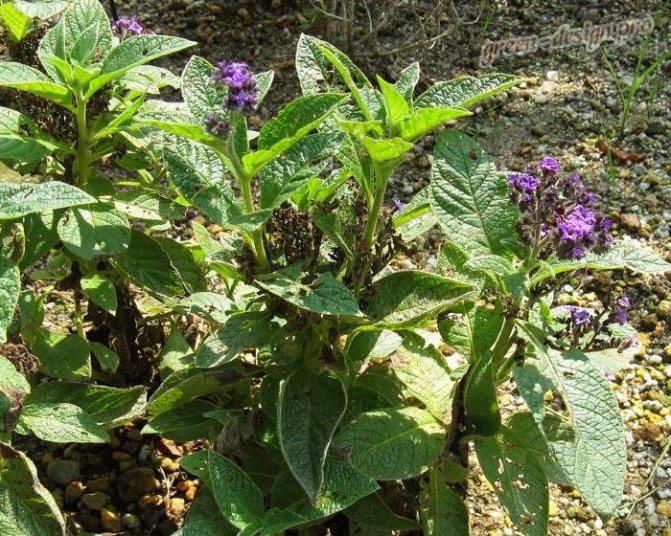

Photo of heliotrope plant
Depending on the species, the height of the bush varies from 20 to 60 centimeters. Shoots form a dense bush shape, abundantly decorated with succulent foliage.
The heliotrope flower is valued by flower growers primarily for the incredible beauty of the inflorescences, which have a thyroid shape, consisting of a large number of small flowers. The inflorescences are large, sometimes reaching 20 cm in diameter.
The color of heliotrope strikes with a deep blue, the shades are so saturated that they seem unreal. Slightly whitish center, towards the edge of the petals acquires a dark, deep blue or purplish blue color. In addition to beautiful inflorescences, leaves also differ in decorativeness. They are inversely ovoid and have a pronounced wavy texture. The leaf blade is covered with fine, soft pubescence.
Seed propagation
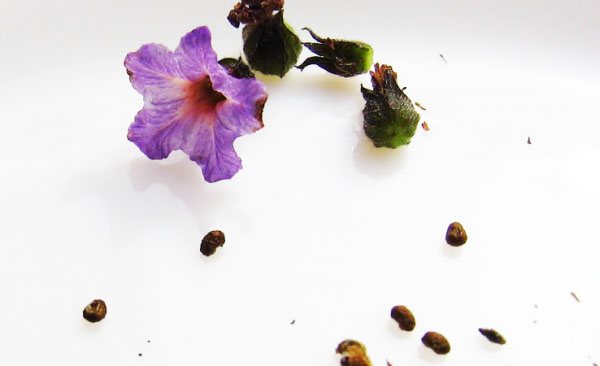

The heliotrope Marine is recognized as the most optimal exhibit for the garden, because it throws out lush bloom and branches well. Experts recommend growing it exclusively with seedlings. The seeds may not produce the necessary shoots. Gardeners practice starting sowing after the last frost has passed - in March. As a result, the first sprouts can be seen in a month, and gorgeous flowering in four. To speed up the process of growing heliotrope from seeds (you can see their photos), you should perform the following procedures:
- The cotton fabric is impregnated with a growth accelerator. Seeds are wrapped in it and left on a plastic tray. As the material dries, add the solution. The procedure is carried out within 2-3 days.
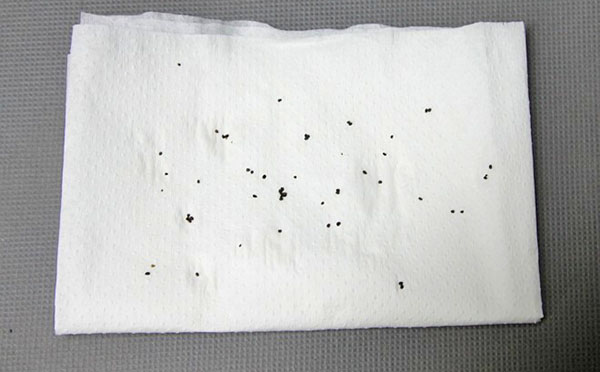

- Instead of ordinary soil, compressed peat tablets are used.
- Soak the seeds in the solution for 24 hours. Silver or zircon is used as a growth accelerator. 6 drops of the selected chemical element are added to a glass with warm liquid. Dry the seeds on a towel before sowing.
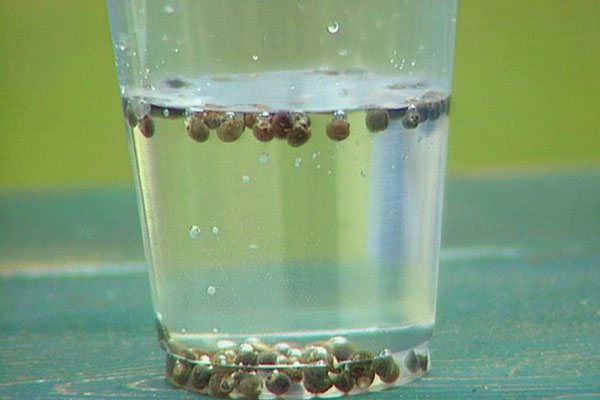

Such actions will protect the heliotrope plant from diseases and pests, and also make it more resistant to temperature extremes. At the same time, the gardener will see the first shoots in 10 days, and not 30.
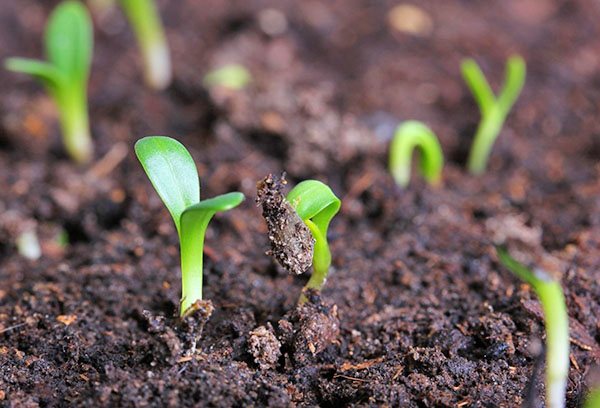

When more than two leaves appear on the stems, and this will happen in one and a half or two months, the seedlings dive in 2 passes. First, they are transplanted in batches of 6-10 pcs. in one container.
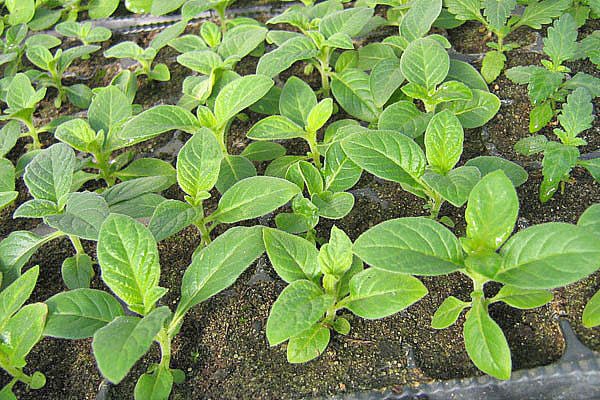

After they grow up a little, they are transferred to pots: individually or in groups (the distance between them is 10-15 cm).
It is important to tie up flowering branches so that the flowerbed looks solid. Otherwise, the heliotrope will "fall apart" on the site, turning into a carpet.
Secrets of growing heliotrope
For vigorous growth and abundant flowering, the plant needs a well-drained, fertile soil. Before planting in the garden, it is advisable to fertilize the soil with organic fertilizers, then the flower will grow better. It is advisable to dilute heavy garden soils with sand in order to improve their drainage properties.
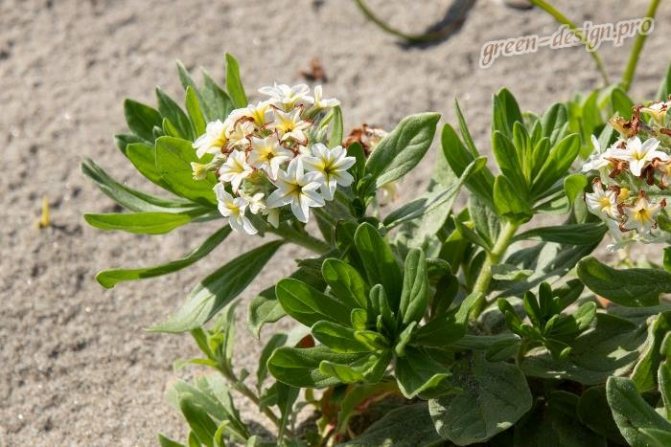

Japanese heliotrope (Heliotropium japonicum)
A flower is planted in a sunny or semi-shaded area. For good flowering, it needs a lot of sunlight. When planted in the shade, the shoots of the plant are unnecessarily stretched, and the shape of the bush is deformed, loses its decorative effect. The heliotrope flower is moisture-loving; in dry weather, the foliage quickly fades.
The plant can be propagated by seed and vegetative method.
Growing heliotrope flower from seeds
For good seedlings, seeds should be sown in late February, early March. It is best to buy seed from a specialized store.Seeds harvested last season in their own garden will give a low similarity, and the seedlings obtained from them will be less decorative.
The seeds of heliotrope are planted in a container with a previously prepared soil mixture. For growing seedlings, garden fertile soil or a purchased universal soil mixture is suitable. Before planting, the soil must be disinfected by soaking it with a strong infusion of potassium permanganate, or pour it abundantly with boiling water.
Seed material is sown on prepared soil, slightly crushed with soil. The top layer of the earth should not be thicker than 1-2 mm. The planting is covered with a film or a protective glass cover. The optimum temperature for keeping seedlings is about 18-20 degrees.
This video talks about growing heliotrope from seeds
From time to time it is necessary to ventilate the container by removing the protective coating, and also to moisten the soil. The first shoots will appear within 2-3 weeks. After emergence, the protective cover is removed, the container is transferred to a sunny place. If possible, the room temperature is raised to 23 degrees. Two weeks after germination, the soil should be fertilized with complex fertilizer. This will help the seedlings become stronger and grow more intensively.
Seedlings are planted in separate containers, which have two good, strengthened leaves. After rooting in separate containers and the emergence of new growth, the plant is fed with complex fertilizer.
With a seedling height of about 10-12 cm, pinch the top, allowing the growth of lateral shoots.
Propagation by cuttings
This breeding option is possible only if in the fall the bush was transplanted into a pot and moved indoors. In March, after the start of intensive growth of shoots on the bush, several healthy shoots about 10 cm long are selected. They are cut off, the cut is treated with a rhizome growth stimulator and planted in a separate container with moistened soil.
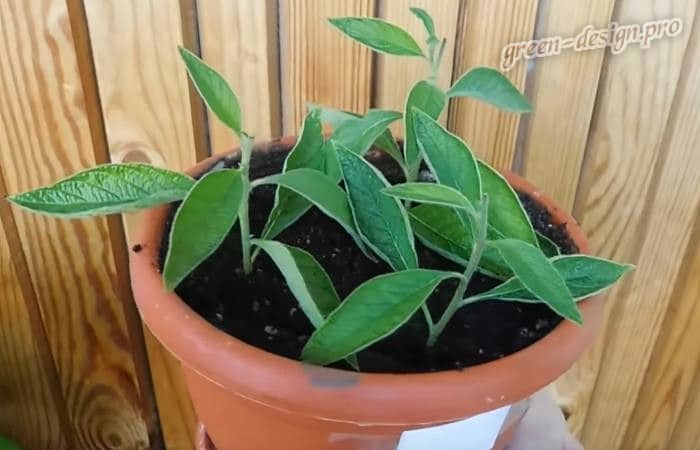

The stalk takes root within 1-2 weeks.
The heliotrope flower, taken from the cuttings, fully retains the properties of the mother bush. It is planted in open ground in May-June, depending on weather conditions.
Cutting heliotrope
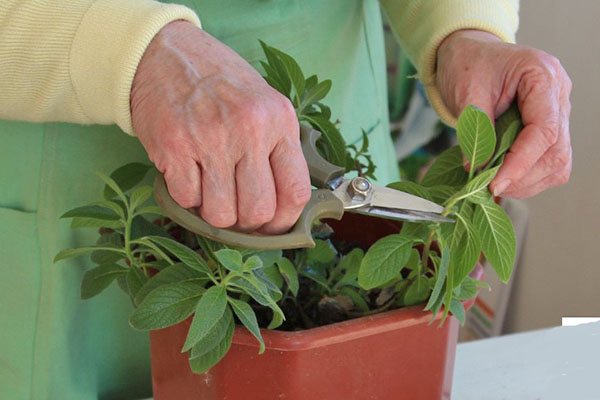

The heliotrope is a tree-like very demanding garden dweller. Yet thousands of gardeners propagate it using cuttings. March and April are favorable times for this method.
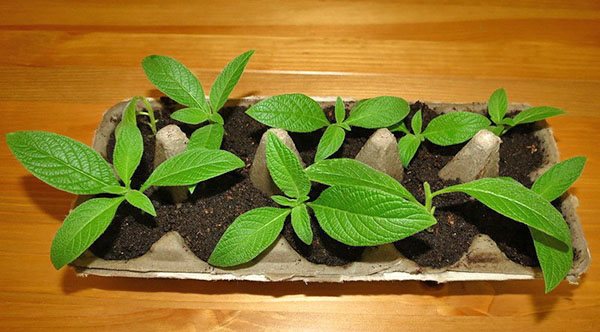

Cuttings are planted in peat soil fertilized with humus. The microclimate should be humid, and the temperature should not be lower than 18 degrees. It is advisable to create a miniature greenhouse for him.
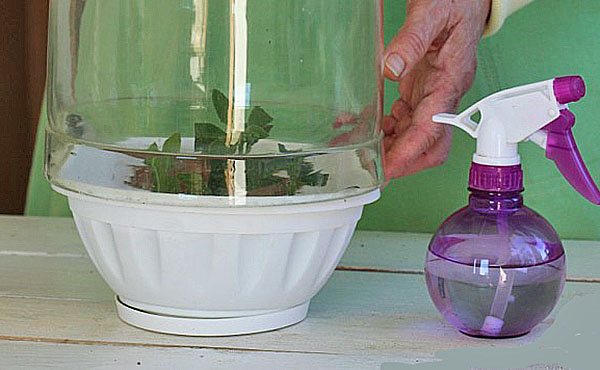

A can or film is most suitable, but do not forget about daily airing. When roots appear, the sprouts are transplanted into separate containers. When the roots take root, they are safely transferred to a permanent place.
Care
In general, heliotrope is an unassuming flower. Although there are several nuances, they should be known for successful flower cultivation:
- it requires regular watering, and in extreme heat - also additional, since the plant does not tolerate drying out of the soil. It is good and easy to spray;
- all the time after watering, the soil around the plants must be loosened, and excess vegetation must be removed. In order to avoid intensive germination of weeds, which can kill the heliotrope, it is recommended to mulch the ground around it. With the help of this simple method, you will preserve moisture and provide the plant with full development;
- it is very responsive to fertilization, therefore, several times a month young bushes need to be fed with mineral fertilizers such as Ideal. From this they develop well and bloom excellently;


Fertilizer "Ideal"
- to improve the development and stimulate the flowering of heliotrope, its tops are occasionally pinched;
- the flower requires protection from a variety of insects that can cause significant harm to it.
Landing
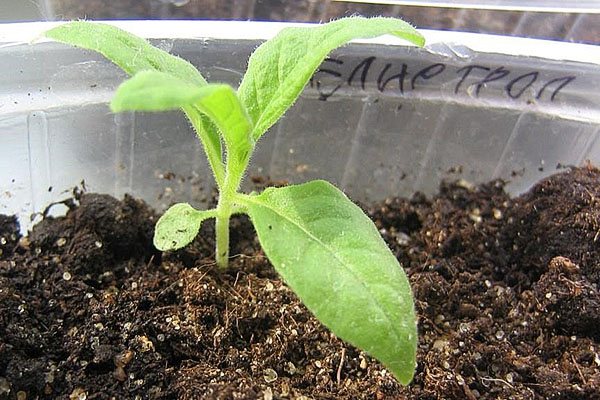

The presentable appearance of the plant depends on the planting substrate, lighting, feeding and regular watering. Leaves wilt and fade if the crop grows in the shade. Therefore, for her, you should choose the southern or southwestern side of the site. At home, the plant in high-quality and daily airing.
You should use a soil without clay admixtures. Loose and lighter substrates should be preferred.
To plant a heliotrope flower, it is worth buying a special soil for shrubs and then providing the seedling with proper care, as shown in the photo. You can create a substrate yourself. This requires the following components:
- sod and deciduous land;
- coarse sand;
- high-quality manure humus;
- charcoal pounded into ash (1-2 handfuls);
- non-acidic peat;
- expanded clay is used as drainage.
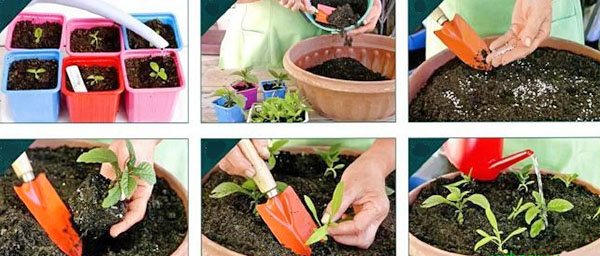

Peat and soil are the largest parts in the substrate, and all the rest should be taken an order of magnitude less. Then you should dig a large hole, lay out drainage on its bottom, fill it with organic fertilizer, and then carefully lay the seedling. The roots need to be straightened, and then covered with prepared soil in small portions.
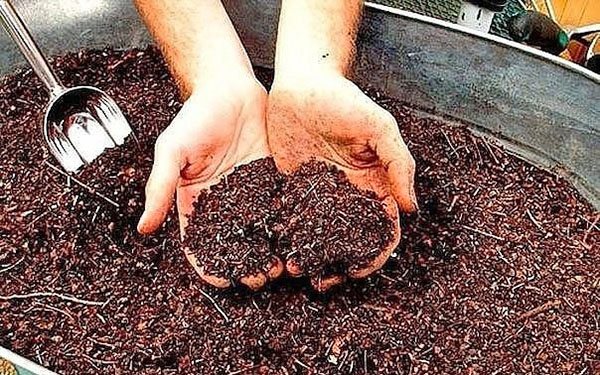

At the end, press the ground near the root collar and water the bush abundantly.
Some sprouts can be pinched off to make the flowerpot more voluminous.
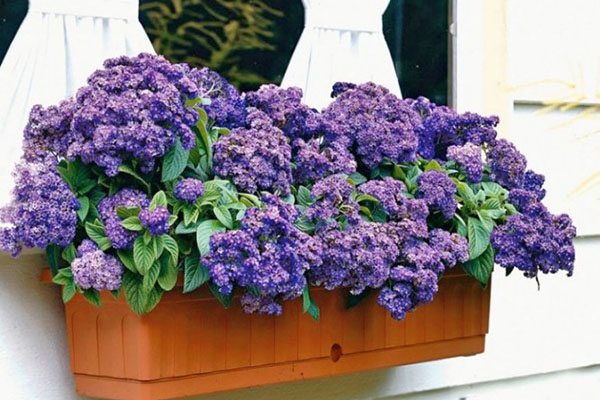

Since herbaceous heliotrope is a very picky plant for open ground, it is advised to water it with soft and settled water (20-25 ° C). It is advisable to spray the shrub every 2-3 days, but it cannot withstand excess water. During the period of intensive vegetation, the soil must be regularly and abundantly moistened.
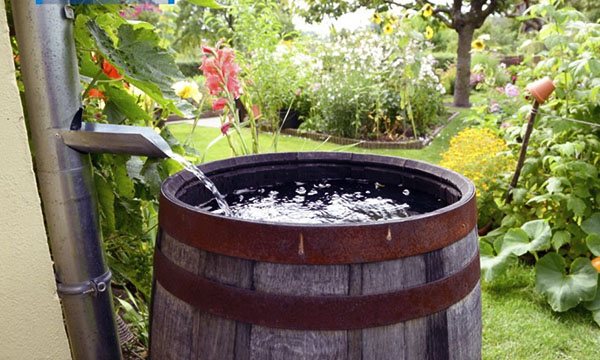

Before each watering, gardeners recommend checking the moisture content of the earth. It should not be wet or dry. Organic and mineral fertilizers, as already noted, are applied before the beginning of the flowering period. Two-time feeding every month to protect the heliotrope from exhaustion.
Rainwater is best suited for irrigation. It should settle a little and warm up well in the sun.
Mulching is an effective method in creating a humid microclimate for the Peruvian heliotrope, as well as other hybrids of this family. You can create such a shelter from any kind of organic matter, namely:
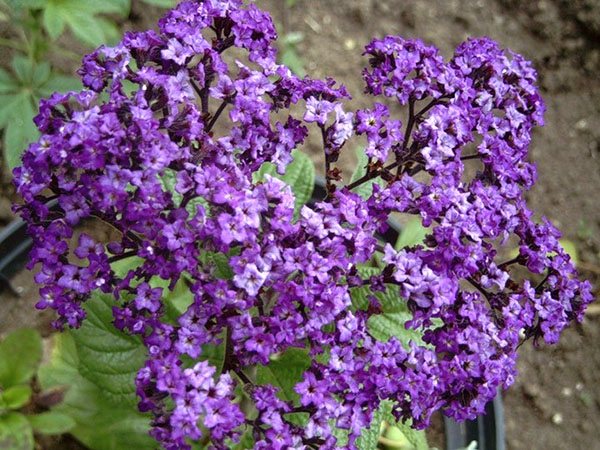

As a result, the gardener will save on water, as well as weeding. At the same time, under such an organic “cover”, the soil will always be loose and moist.
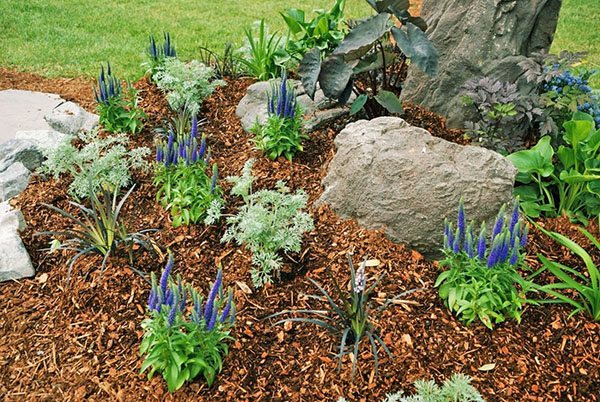

Mulch is made up to 10 cm high. Sadly, heliotrope is a tasty morsel for:
- spider mite (a sign - the leaves are crumbling);
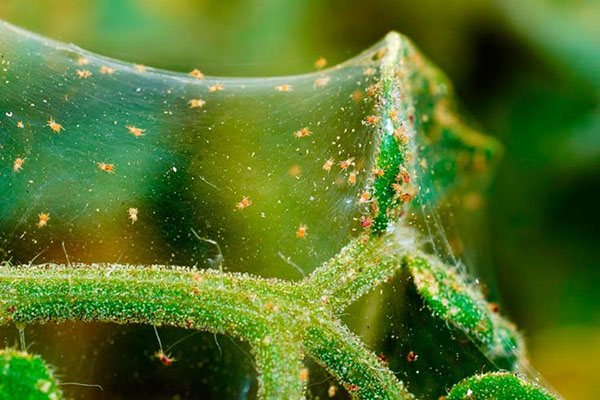

- whitefly;
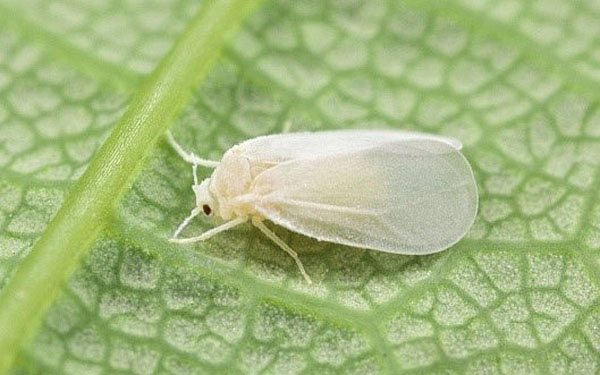

- fungal bacteria (gray mold and mold);
- aphids.
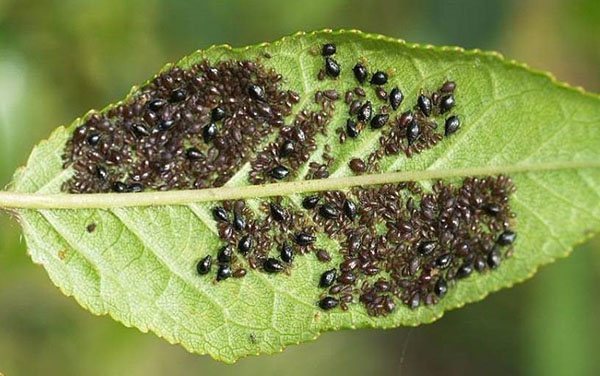

In the fight against fungal pests, antiseptic preparations (fungicides) are used. Spraying is carried out once a week until the disease disappears completely. To kill the tick, just spray the bush abundantly 3 times a day using soft water.
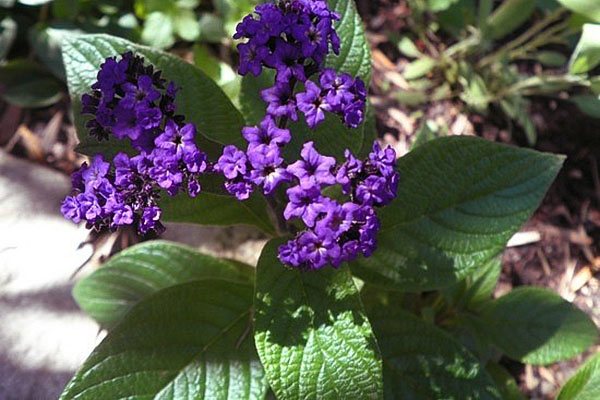

In October, it is advisable to dig up a bed with the remaining parts of the plant. For the winter, it is recommended to apply fertilizer so that it rotted in the ground before the next planting.
You can make a perennial from an annual. To do this, at the beginning of autumn, it is dug up with a lump of earth (diameter 30 cm). Transferred to a large pot with a large hole at the bottom. Place the flowerpot in a room with a temperature of at least 7 ° C. Watered using a pallet, because the culture is at rest.
Despite its whimsicality, this inhabitant of the Mediterranean takes root well on the territory of Russia, Belarus and Ukraine. However, in regions with harsh winters, heliotrope is often grown at home.
Growing heliotrope at home - video
Heliotrope flower: use in landscape design
Heliotropes are outdoor herbaceous plants that are often used to decorate flower beds and create living borders.
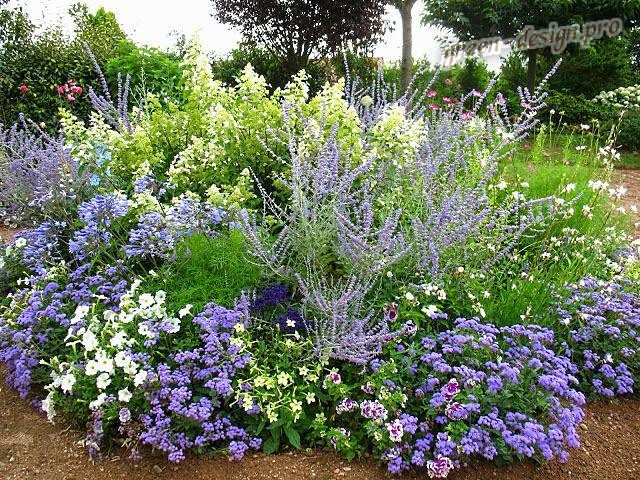

Its strong bushes, abundantly decorated with flowers, will also look good in pots on open terraces, recreation areas.
Considering the fragrance of flowers located not far from the recreation areas, they saturate the atmosphere with a delicate aroma of vanilla, making it more comfortable and pleasant.
Arboreal heliotrope
• seedlings appear in 14-20 days; • seeds in the temperate zone rarely ripen (in October); • when propagated by seeds, seedlings are heterogeneous, bloom in autumn, form small inflorescences
• previously propagated only by cuttings, recently varieties propagated by seeds have appeared; • mother liquors are stored in a greenhouse in winter at a temperature of 8-10 ° C; • strong apical shoots go to the cuttings; • • cut into the ground of the rack at a temperature of 20-25 ° C;
About 250 species are known heliotrope, a plant whose peduncles always "look" at the sun and turn, "following" it. In nature, heliotrope grows in the tropics and subtropics.
The most popular variety is Marine. In the garden, it is an annual, and when grown as an indoor flower, it is a perennial.
Heliotrope after flowering
From what has been said, it is clear that growing and caring for this blooming and fragrant handsome man is not so difficult. What can not be said about its reproduction. This process can bring a lot of trouble and frustration to the amateur florist.
However, in the event that you want to test your skills, then wait until the inflorescence “dies”, that is, it completely dries up and acquires a black color. Then you can get the grains from the seed pods and, after drying them, send them for storage.
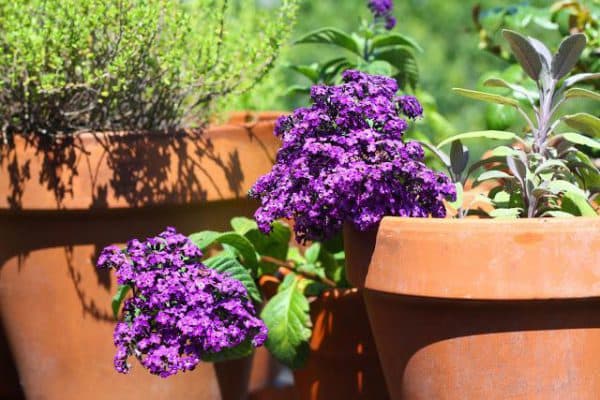

Potting
With the onset of autumn cold weather, heliotrope is removed from the sites. However, in order to preserve it in winter and enjoy excellent flowering on cold days, you can dig up the plant by the root before the frost and plant it in a flower pot to size, and then bring it into the house. Providing heliotrope with the right light and the right air temperature, you will soon be able to enjoy the pleasant aroma and wonderful appearance of its inflorescences. And in the spring, this flower can be propagated by cuttings, after cutting them off and rooting.
Features of the variety Marine
"Marine" - treelike heliotrope, grows up to half a meter in height. Its origin is Ecuadorian and Peruvian.
At home, it is a perennial plant, its height can be about 2 meters. In our conditions on the street heliotrope does not hibernate.
Inflorescences deep blue-violet color, 15 centimeters in diameter. It grows and develops rapidly.
First bloom - in the same year as sowing. Blooms from June to the beginning of frost. Marina hybrids - Mini Marine, Dwarf Marine and Marine Blue.
Signs of the genus heliotrope:
- leaves with short cuttings;
- the arrangement of the leaves is next;
- small flowers, collected in inflorescences in the form of scutes;
- coenobium - a fruit consisting of 4 nut parts - contains very small seeds (1.5 thousand seeds weigh only 1 gram);
- aroma due to the content of essential oil in the inflorescences (vanilla smell).
Varietal variety of heliotrope
The treelike heliotrope flower (Heliotropium arborescens), also called Peruvian, has become widespread. The height of the bush reaches 60 cm, has a dense, spreading crown, abundantly decorated with bright foliage. The diameter of the inflorescences is about 15 centimeters. The flowers are deep blue or purple.
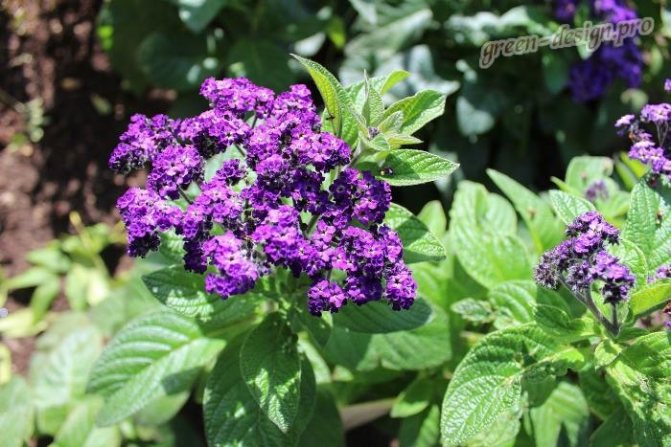

Treelike heliotrope (Heliotropium arborescens)
Thanks to selection, this species became the ancestor of many plant varieties that take root well in our climatic zone. Of these, they are distinguished by the greatest decorativeness:
- Mini Marine. It has a miniature bush shape, the height of which reaches 35 centimeters. The flowers are violet-blue, the leaf plates are dark green in color.
- Black Beauty. The bush grows up to 0.4 meters, has a compact shape. During the flowering period, it is decorated with a large number of purple inflorescences, which have a light, pleasant aroma.
- Fragrant Delight.The height of the bush reaches 0.4 m. Differs in unusual flowering. The middle of the flowers are painted in a delicate lavender color, which acquires a more saturated shade to the edges of the petals.
Among the dwarf varieties, it is worth noting the Regal Dwarf heliotrope flower, the height of the shoots of which does not exceed 0.3 meters, the inflorescences are dark blue, exude a pleasant, light aroma.
Seat selection
A place for the Marine variety, you need to choose a sunny one. He prefers loose soil, with good water permeability and an abundance of organic matter. It is great if the plant is protected from rain and wind.
Except gardens, the flower is grown in rooms, on balconies, on terraces, in flower beds. Borders are formed from heliotropes.
Read about the reproduction of syngonium with us.
Caring for sheffler flowers requires skill. More about this.
What plants to plant
Heliotropes look neat, pleasing to the eye on the flower bed. They go well with plants with light foliage, yellow, pink, blue, less often white, flower. For example, in the photo below, the rose is highlighted with purple heliotrope, and the purple one-year-old phlox goes well with it:
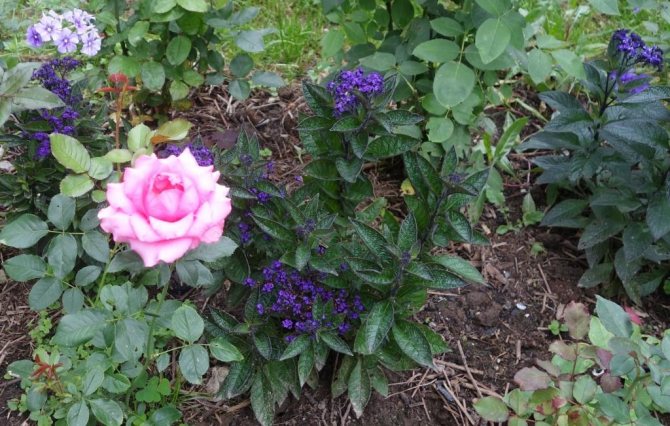

Flowers such as various marigolds, daylilies, roses, some hosts, variegated incense are a good neighborhood.
Landing in open ground
Seedling it is planted in open ground when the frost stops, before the heliotrope begins to bloom.
To prepare shoots to this procedure, they are previously periodically taken out into the street, hardening. Hardening begins at the end of April.
When landing between the shoots leave from 20 to 30 centimeters, and put humus (leaves or manure) in the holes. In the first week after landing in the Marine soil, provide shade and spray with water twice a day.
Sowing procedure for mature seeds
To enjoy the bloom of heliotrope throughout the summer, its selected seeds are sown in late February and early March. To begin with, a special substrate is prepared: 4 parts of natural peat are mixed with 1 component of sand, then it is calcined in a mixed form to get rid of an unnecessary fungal infection of the soil.
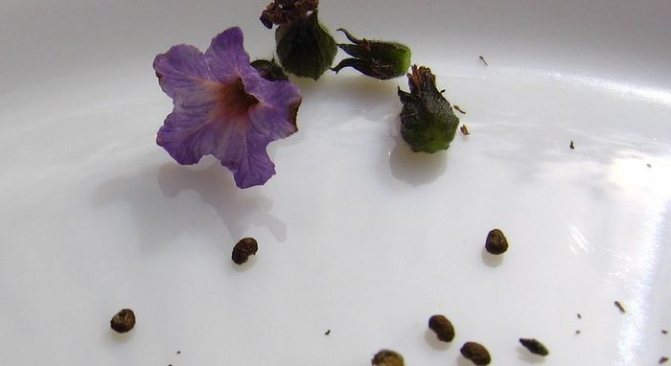

Mature seeds of ornamental heliotrope are so small in size that it is quite difficult to see them on the surface of the earth, so they are simply sown on the surface, slightly covered with earth on top.
The planted seeds are covered with old glass, placed in a room where the temperature is maintained at least 20 ° C. After pecking the seeds, the glass is removed, they are left for further development in a place where the air temperature does not drop below 22 ° C. After the appearance of 2-3 leaves, young heliotropes are seated in separate pots, well watered. We start complex feeding from the 20th day, using a special composition for seedlings.
When germinating seeds, do not lose sight of the fact that for the emergence of fast shoots, you need to extend the daylight hours for them to 10 hours, moisten the outer surface of the soil in the greenhouse.
Reproduction
First heliotrope propagated exclusively by cuttings. With the development of breeding, varieties appeared, the reproduction of which became possible not only by cuttings, but also by seeds. Among them is the heliotrope "Marine".
Cuttings... The mother plant is carefully dug out of the soil with an earthen clod, placed in a container and brought into a warm room for the winter.
To water it is needed as the soil dries up. In February (in the middle of the month) cuttings are made from it. Each shoot should have 3 or 4 internodes. There is no need to leave a lot of leaves on the shoot: this will weaken it.
In boxes sand and humus are poured in a ratio of 1: 2. There should be a layer of sand 1 cm thick on the surface. The substrate is abundantly watered and compacted. Before planting the cuttings, they are kept in a special composition for root formation.
After disembarking in the substrate, the shoots are covered with a film and wait for the roots to appear, watering the cuttings daily and airing them for half an hour, opening the film. Usually, it takes 3 weeks for the roots to form. Then the cuttings are transplanted into the soil, which is more nutritious in its composition: peat, turf and sand in a ratio of 4: 2: 1.
The soil is fertilized complex fertilizer containing minerals. For the first week, young plants should not be exposed to direct sunlight; 2 times a day, they should be sprayed with water at a temperature slightly higher than room temperature.
To give the compactness of future bushes, seedlings are repeatedly pinched as they grow. They are planted in open ground at the end of the frost in the spring, leaving a distance of 20 centimeters between the plants.
Seeds... Planting months are January, February, March. To grow seedlings, Russian seed producers recommend scattering heliotrope seeds over the surface of the earth, pressing them, but not covering them with anything. European growers recommend covering sprinkled seeds with a 3mm layer of soil.
Germination period - up to 20 days. The boxes should be kept warm and lighted, as light is needed for the seeds to germinate. After 37 days, the sprouts are distributed in separate containers and placed in a cooler, ventilated room.
Branching European heliotrope
Despite the name of the species, it can be seen not only on the territory of Europe itself, but also in South America. This plant has a compact form, can reach only 40 cm in height, has a strong branching stem. Lovely curls of this heliotrope form lush inflorescences. Abundant flowering is observed from May to August.
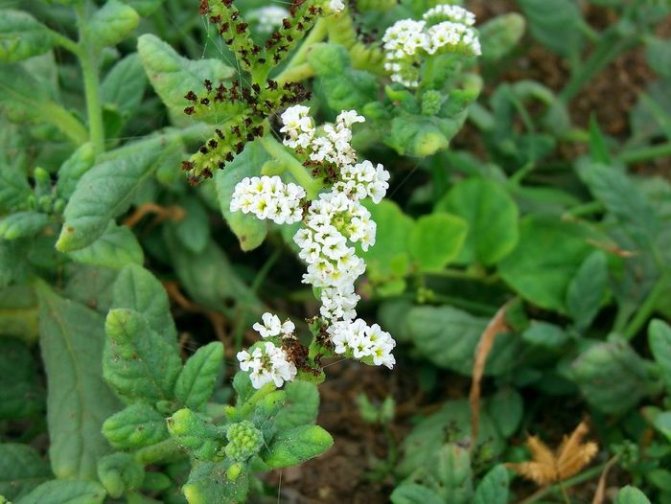

High Kurasavsky grade
This type of flower stands out among others for its volume, its bush is quite high, it can reach 120 cm in width, it grows up to 100 cm in height.
Compact Stem Enveloping Heliotrope
For unknown reasons, this flower variety has not earned popularity among experienced florists. It has long leaves, gives inflorescences of a light purple color.
Planting heliotrope - step by step instructions
- In open ground, heliotrope seedlings are planted when the last frost has passed. Usually this process occurs in June, since the cultivation of plant seedlings takes a lot of time.
- Before planting, it is recommended to once again loosen the soil in the area of your choice, since the plant prefers to grow on loose and light soils.
- Prepare planting holes. the size of which should be slightly larger than the root system of seedlings with an earthy clod. If you are planting seedlings in peat pots, then the hole should be slightly larger. It is necessary to maintain a distance of 15-20 cm between individual planting holes, since the heliotrope grows quite strongly.
- Pour some dung and leafy soil at the bottom of each pit.
- Then carefully remove the seedlings from the pots and place them in the holes. Try not to damage the earthen ball.
- Cover the seedlings with soil, gently pressing the soil against the base of the plant stem.
- After planting, it is recommended to water the young plants abundantly and mulch the soil around them with peat or sawdust - this will reduce the amount of loosening and prevent moisture evaporation.
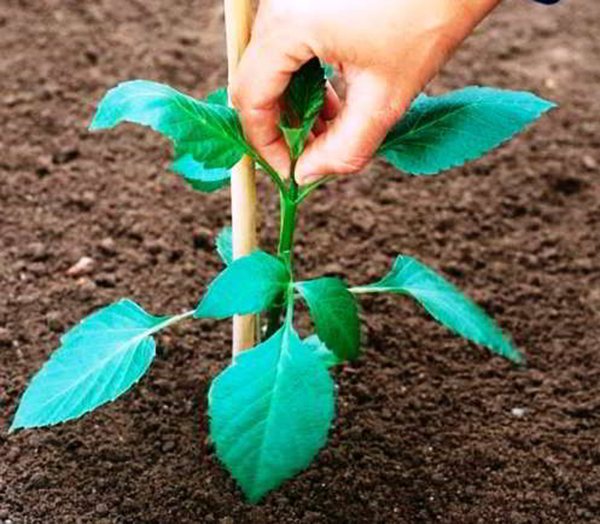

The legend of the heliotrope flower, signs and superstitions
There is a sad legend about the origin of the magnificent plant. Cletia, a charming nymph, was in love with Helios, the patron saint of the sun. Feelings were unrequited, and the beautiful Leukofia became his chosen one. An angry girl slandered her rival dirty, for which the king ordered to bury the liar alive. She lay to death without food or drink, watching her lover roaming the firmament with her gaze. The gods, touched by the grief of the nymph, turned her into a magnificent flower, relentlessly following the sun.
Also, the plant is considered magical.Roman soldiers carried heliotrope seeds in a canvas bag as a talisman against evil forces. It is one of the plants worshiped by the Order of the Rose and the Cross (Rosicrucians) and displayed in the tarot card arcanas. Esoteric Paul Sedir called the flower the patron saint of July. If a person suffering from somnabulism (walking in a dream) is hypnotized with this herb, he will remember his night movements and actions.
This is the herb of truth: if you bring it to church, then walking wives will not be able to leave it; wrapped together with a wolf's tooth in a bay leaf heliotrope, "will not allow to speak evil" on the wearer of such a talisman.
The nuances of growing
Marin's heliotrope flowers are very delicate. When water gets on them, they quickly wither, so the plants are recommended to be watered at the root. It is worth noting that this type of heliotrope, as we have already mentioned, is capable of propagating by seeds. However, in terms of the intensity of the smell, it is significantly inferior to those varieties that reproduce only by cuttings.
Arboreal heliotrope is popular for its appearance. But there is always a risk of turning a tall bush into a ground cover plant. Therefore, gardeners sometimes have to tie them up. Marine is suitable for growing not only indoors, but also outdoors.
Selection of the optimal landing site
The beautiful heliotrope is a sun-loving plant, for it you need to prepare a well-lit place, but it should not be too much of the scorching sun. Such plots of land are also not suitable for his landing. With an excessive moisture content in the soil, the plant may die, so you should not choose lowlands or banks near river reservoirs.
Preparing the potting mix
The best option for the development of a beautiful heliotrope is a lush fertile soil with a high humus content. Loamy soil with a heavy composition can be significantly lightened by adding a little high-quality peat and sifted sand to it.
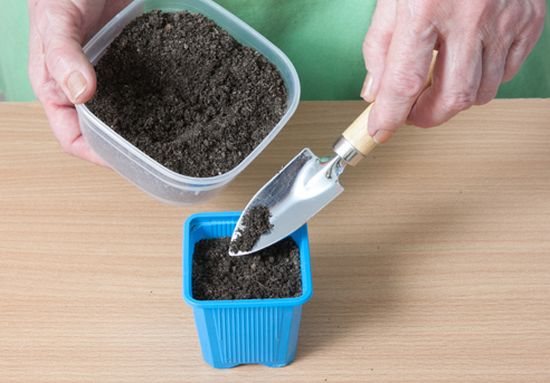

How to plant ready-made heliotrope seedlings correctly?
First, you need to prepare the seedling holes in advance by adding a little mixed leaf earth and humus there. Then we plant the seedlings by the transshipment method, while it is important not to disturb the earthen lump with delicate roots. The hole around the planted flowers is sprinkled with fertile soil. Due to the decent volume of adult flowers, planting is carried out at a distance of 30 cm from each other. Immediately after the end of planting, the seedlings are immediately watered abundantly with warm, settled water. Within 2 weeks from the moment of planting, it must be watered three times a week. After that, you can switch to abundant watering if necessary, if the outer layer of the soil dries out.
Proper care of lush heliotrope
Some experienced growers believe that a beautiful heliotrope is a capricious plant. In fact, this is far from the case. It is necessary to provide him with the correct watering regime, since he loves water procedures very much, but does not tolerate its excess. Therefore, it is important to find the right balance here. The process of caring for this ornamental plant is simplified if you mulch the soil around it with compost or high-quality peat. This measure will reduce the number of soil loosening, it will need to be weeded out of annoying weeds much less often, and the number of irrigations will also be reduced. If you want to enhance flowering, then you need to periodically pinch the tops.
Rules for the propagation of a heliotrope plant by cuttings
Reproduction of heliotrope by cuttings is practiced quite often, but in order for this method of propagation to give a good result, certain rules must be followed.
Cuttings are obtained in March - April from mother plants that overwintered in greenhouses or in pots. To do this, the bush is dug up in late autumn and stored in a cool room, as described above in the "Wintering" section.In the second half of March, heliotrope is cut off, transplanted into fresh fertile soil, care is continued in the form of irrigation as the land dries up and fertilizers are applied. The side shoots are shortened to make the bush more lush. The resulting branches are cut into cuttings about 5 cm long. A couple of leaves are cut from the bottom, the upper leaves are cut in half. To activate the growth of roots, before planting, the cuttings are recommended to be kept in the Epin solution, or treated with another preparation that stimulates root formation.
Finished cuttings are placed in small containers, for example, peat pots, filled with a mixture of peat, sand and vermiculite, and covered with a glass jar or dense polyethylene. For germination, they are removed in a cool, well-lit place, if necessary, use additional lighting so that the plant is under the light for at least 10 hours a day. Watering is carried out at the root as the earthen coma dries, adding the preparation "Zircon" to the water.
When the cuttings have roots, they will need to be transplanted together with a peat pot by transferring them into a more spacious container with a diameter of 8-10 cm.
Rooted cuttings are planted in open ground in May - early June at a distance of 25 - 30 cm. For better branching, it is recommended to pinch the seedlings, then the bushes will become more luxuriant.
Below is a video showing the cutting of heliotrope, by watching which, you can understand all the nuances of this method and avoid failure in this work:
What does the name of the plant mean?
The flower got its name from two Greek words: "helios", which translates as "sun", and "trope", which means "turn". This is due to the special property of Heliotrope - to turn the inflorescences throughout the day in the direction of the sun's movement.
We recommend related posts:
Sapodilla - growing at home
Asparagus - description, home care
The people often refer to the plant as Litmus dyeing and Lishaev's grass. The British call Heliotrope Cherry Pie, the French call it the Grass of Love, and the Germans call it the Grass of God.
Photo of heliotrope
Heliotrope is a beautiful and delicate flowering plant that has an incredible vanilla scent. Planted on the site, it will become a real exotic decoration of a flower garden or flower bed.
Advantages and disadvantages
Heliotrope is deservedly popular with gardeners, as this plant has the following advantages:
- unpretentious character;
- ease of care;
- large inflorescences;
- pleasant aroma;
- long flowering.
The disadvantages include weak frost resistance, due to which it is impossible to grow a flower in the open field as a perennial. And also gardeners note that the plant is too susceptible to drought, so it needs to be watered often, especially in hot weather.
Simple ways to breed heliotrope
If you intend to distribute heliotrope in your area, then it is better to use high-quality cuttings for this. To this end, you need to save one adult plant for the winter, because it is almost impossible to take a cutting from an annual growing in the garden. For this purpose, you need to choose a developed, well-growing plant, transplant it into a pot.
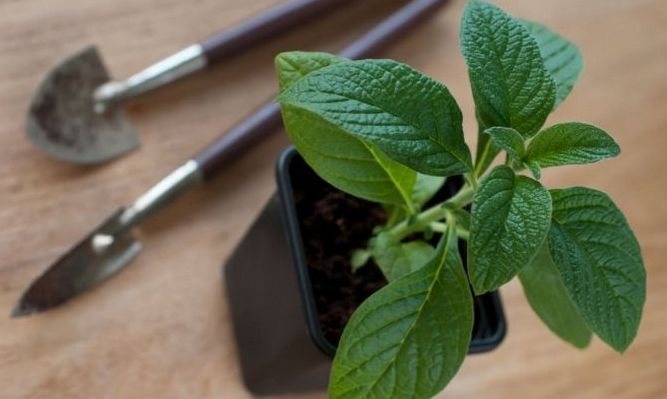

heliotrope reproduction photo
The optimum temperature for it in winter should not exceed 18 ° C. If the total temperature of the content of the tropical plant is higher than the indicated one, then the young shoots will stretch strongly, weaken. At the beginning of February, you need to select the youngest shoot, it needs to be divided into cuttings. All slices are processed with root roots, planted in pots. As adult flowers, young heliotropes also require additional illumination.
Dangerous diseases and pests
This flower is susceptible to various fungal diseases. This requires urgent treatment with special fungicides. Various insecticidal compositions are used against various dangerous pests.To completely get rid of "annoying guests", it is necessary to spray heliotrope with a break once a week.
What does heliotrope shrub look like?
Not everyone knows what a heliotrope looks like, meanwhile, this is a perennial or annual plant, which reaches a height of 30 to 60 cm, has strong, straight, dark green shoots. The leaves are large, bright green, slightly pubescent, have an elliptical shape, drooped down, smooth or wavy along the edge. Sometimes the leaf plates can be wrinkled. Attached to short petioles.
This culture is distinguished by large multi-flowered inflorescences. Inflorescences are dense dense shields. The flowers are small, blue-purple in color, with a wonderful vanilla aroma, and contain essential oils.
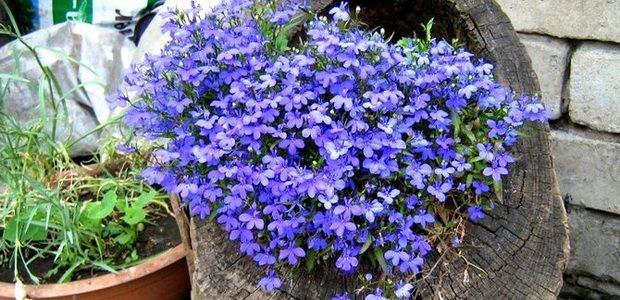

The heliotrope shrub begins to bloom in July, flowering lasts for 28 - 30 days. Some varieties bloom until frost. After flowering, fruits are formed on the plant, which, when fully ripe, break into four parts. The inside of the fruit contains a large number of small, dark brown or black seeds.
It is noteworthy that the buds of this plant turn towards the sun.
In the southern regions, heliotrope is grown as a perennial crop, in middle latitudes - as an annual.
To better understand what a heliotrope flower is, having studied its description, look at the photo below, where all its characteristic features are clearly visible:
The benefits and dangers of the plant
In addition to decorating the garden, heliotrope inflorescences are used in perfumery. High society, conquered by a wonderful aroma, gravitated towards it, then tuberose came to replace it.
In some species, the leaves and stems contain toxic substances alkaloids - cinoglossin, and the seeds - laziocarpine and heliotropin. When ingested, they have a paralytic effect on the central nervous system of humans and animals. Dangerous species of heliotrope are not cultivated in gardens. The presence of poison allows the plant to be used for medicinal purposes, but this is not recognized by official medicine.
So, decoctions and infusions from the dried herb of European heliotrope are taken against helminths, prostate adenomas and kidney stone disease, they wash wounds with drugs and make baths for lichen. Fresh leaf gruel is applied to benign tumors and warts. Treatment should be supervised by a physician. For children, pregnant and lactating women, elderly people, the use of such drugs is contraindicated.
Growing
Heliotrope grown from seeds blooms in 3-4 months. In order to fully enjoy the flowering, which continues until the onset of stable cold snaps, it must be sown for seedlings in late February or early March.
You should not take the seeds of this culture from friends: they are unlikely to please with good germination, since they often do not have time to ripen in our climate. Such seed is likely to give bushes of different heights, which will be inappropriate when making a group planting in a flower garden. It is better to purchase a package of seeds in a specialty store.
Potential diseases and pests and their control
In general, heliotrope is quite resistant to various diseases and pests, but sometimes it can be affected by aphids, whiteflies and spider mites. To combat them, the plant is treated with an insecticide, and sometimes re-treatment is required after a week. Experienced gardeners most often use Aktellik.
Important! In order to prevent possible damage by insects, heliotrope bushes in early spring and autumn are best treated with insecticides.
Among the diseases, rot and rust are dangerous for heliotrope.
Gray rot
Brownish spots, covered with gray fluff, begin to appear on the leaves, which eventually begin to turn black from the presence of pathogens on them. The affected parts of the plant should be immediately removed and burned, as this fungal disease can simply spread with the wind.After that, the remaining plant is treated with either copper sulfate or copper oxychloride.
In order to prevent this unpleasant disease, one should not allow thickening of the plantings and the formation of stagnant air, and also not be zealous with nitrogen fertilizers.
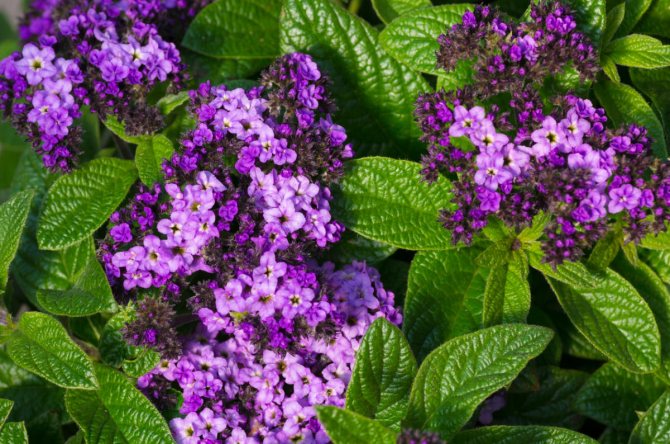

Heliotrope grown in the country will certainly become your pride
Rust
At the beginning of the growing season, in the spring, orange spot-pads appear on the leaves. If untreated, the branches begin to deform, and the leaves themselves wither. Treatment consists in the immediate destruction of the affected parts of the plant and treatment with a solution of Bordeaux liquid or colloidal sulfur.
The heliotrope color will not leave anyone indifferent, therefore, by planting this plant on your site, you can not only decorate the flower bed, but also get an incomparable fragrance for the whole summer - the plant will smell as soon as its inflorescences begin to bloom. In addition, this magical shrub will surely bring harmony and happiness to the house.
Varieties
Heliotrope Marine is presented in several varieties:
- Princess Marin is a plant that does not exceed thirty centimeters in height. Its small inflorescences are colored bluish-purple.
- White lady. Low-growing form with abundant flowering. After blooming, pink buds turn into small white flowers.
- The sea dwarf is a very decorative miniature species. The bright inflorescences are blue and have a pleasant aroma.
- Odysseus. The plant variety reaches a height of no more than thirty centimeters, but at the same time it has large velvety flowers of a bright lilac hue.
- Sea Breeze is a medium sized plant. Sprawling bushes grow up to 50 centimeters. The foliage of the plant is colored dark green, and the inflorescences are blue. The flowering period lasts from June to the end of October.
- Heliotrope Marine mini is another undersized form, reaching a height of only 25 centimeters. It differs from other varieties in its color. The foliage is green with a purple tint.
Types and varieties of heliotrope with photos and names
The genus, numbering up to 300 species of plants, allows you to grow several of them in the garden without fear. Through the efforts of breeders, varieties of stunning beauty have been bred.
Heliotrope Peruvian or Peruvian or treelike Heliotropium peruvianum syn. Heliotropium arborescens
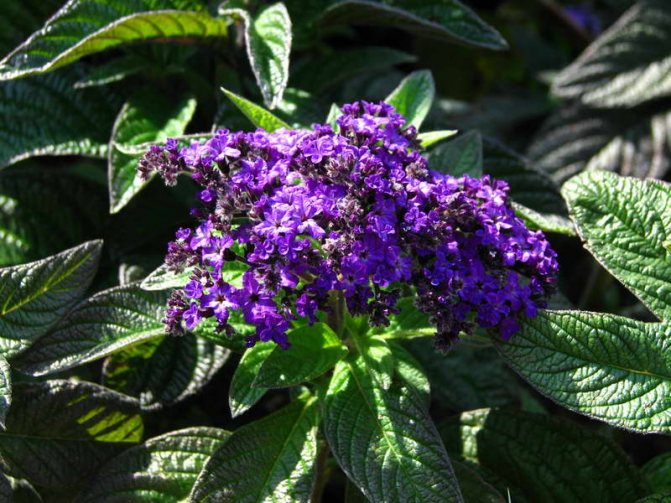

Herbaceous plant up to 60 cm high with leathery dark green leaves. Small corollas of a dark blue or dark purple hue are collected from a panicle with a diameter of 10-15 cm. The frost stops flowering.
Stalk heliotrope Heliotropium amplexicaulis
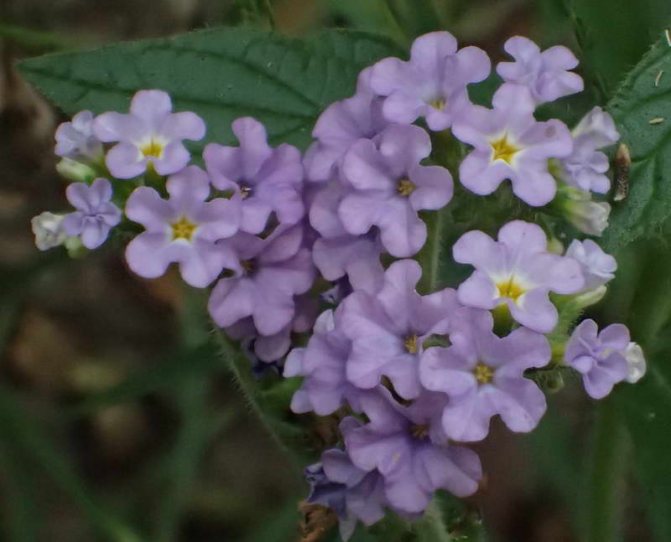

Stunted view. Other names: blue heliotrope, compound heliotrope, creeping heliotrope, heliotrope, purple, summer heliotrope, turnstile, purple heliotrope, wild heliotrope, wild verbena. Originally from South America (i.e. northern and central Argentina, southern Bolivia, Uruguay and southern Brazil). This species is widely naturalized in eastern and southeastern Australia. Widespread in coastal and sub-coastal areas of southern Queensland and northern New South Wales, and relatively common in southeastern South Australia and other parts of New South Wales and Queensland. Also recorded in other parts of South Australia and moderately naturalized in northern Victoria.
It is a perennial herb with creeping (outstretched) branched stems extending outward from the tree rhizome. It usually grows only 15-30 cm in height.
Small tubular flowers (4-6 mm long and 3-6 mm wide) are arranged in two rows along one side of a spiral flower thorn (i.e., boragoid inflorescence). However, these flower heads straighten and lengthen as the fruit ripens. The flowers are purple, lilac, blue or pinkish in color and have a characteristic yellowish throat. They consist of five petals that are fused with a tube (i.e.corolla tube) for most of their length, and are surrounded by five green hairy sepals (about 3.5 mm long). Each flower also has five small stamens inside the flower tube and a four-petal testicle topped with a very short style and a wide hairy mark. Flowering occurs throughout most of the year, but is most noticeable from late spring to early fall.
The fruit consists of two small "seeds" (that is, nuts or mericarps), which are separated from each other in adulthood. The seeds are round (i.e. subglobular) in shape and have a wrinkled or warty surface. They are dark brown or black in color and hairless (i.e. naked).
Shield heliotrope Heliotropium corymbosum
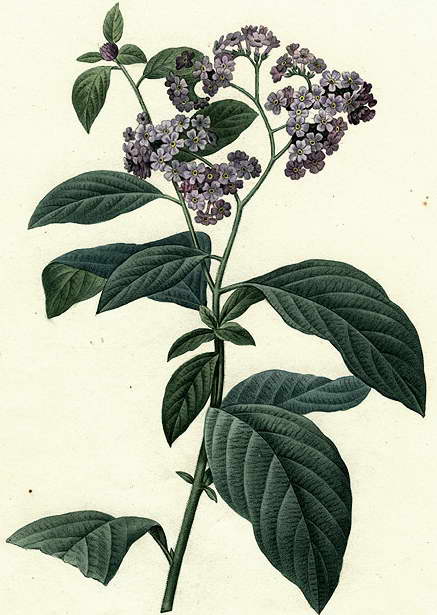

In this species, the leaves are smaller, and the inflorescences are more luxuriant.
Medicinal properties
In addition to its delicious scent, heliotrope also has some medicinal properties that are used by experienced herbalists. These are anthelmintic effects, external burning of warts and lichen treatment, as well as the ability to help with kidney stones. However, the independent use of the plant for medicinal purposes is extremely dangerous and is categorically not recommended by doctors due to the possible content of poisonous alkaloids. So, recently, the plant in this capacity was withdrawn from the market and banned by health authorities in Germany.
Heliotrope Sea Breeze: growing from seed
Before planting seeds, it is recommended to steam the soil with boiling water. This is done in order to prevent fungal diseases that may appear as a result of early sowing, since the duration of daylight hours during this period is still very small.
- Pour the slightly moistened soil mixture into a container and compact with a board.
- Spread the seeds evenly on the surface and lightly sprinkle them with earth (1-2 mm layer). This method of sowing will keep the seeds from drying out.
- Drizzle in small portions until the soil is completely saturated with water.
- Put the containers in a plastic greenhouse or container and put them in a warm place. The temperature must be at least + 18-20 ° C.
- When shoots appear, take out bowls with crops from the container and place them on the windowsill. The optimum temperature for seedling development is + 20-22 ° C.
Heliotrope Seeds germinate within 5-20 days, in rare cases - up to 28 days. But still, if after 21 days the seedlings did not appear, it is better to repeat the sowing. Heliotrope tolerates a lack of light well, but still it is better not to plant it on northern and shaded windowsills.
Heliotrope pick
Plant picking is carried out after the appearance of two true leaves. Each seedling must be dived into individual containers of 9 * 9 cm. The soil mixture can be the same that was used for sowing.
If necessary, the roots should be first untangled with a toothpick so that they are located in the ground without bending exactly.
Water the seedlings, and 14 days after the pick it is recommended apply any fertilizer for seedlings, strictly follow the instructions on the package.
Description
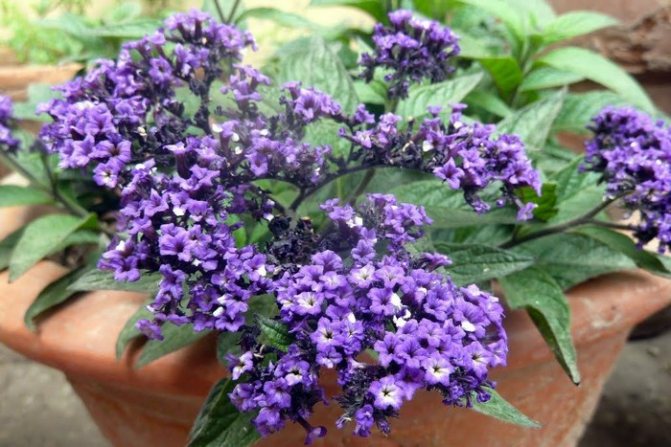

The heliotrope is a treelike native to Peru, a shrub or subshrub in its natural habitat grows up to 120 cm. Height, 30-90 cm depends on the variety. Flowering period, blooms July-September, about 16 weeks after sowing. Flower color, the species has violet-blue or blue-lavender flowers, varieties are purple, violet or white. A place, only sunny places. Frost resistance, heliotrope dies at 2 ° C.
Planting and caring for heliotrope
- Landing: sowing seeds for seedlings - in late February or early March, planting seedlings in the ground - in early June.
- Bloom: from June to frost.
- Lighting: bright sunlight.
- The soil: fertile, loose, well-drained and rich in humus.
- Watering: as needed: young plants - often, adults - after the topsoil has dried.
- Top dressing: from the seedling period to the peak of flowering, once every 2 weeks with a complete mineral fertilizer.
- Reproduction: seeds and cuttings.
- Pests: aphids, whiteflies, spider mites.
- Diseases: gray rot, rust.
Read more about growing heliotrope below.
Features and description of heliotrope
Heliotrope is a fairly well-known perennial semi-shrub or herbaceous plant that belongs to the Borage family. On the territory of Russia, this flower is grown as an annual plant in the open field and as a perennial flower at home. The heliotrope is a guest from the tropics and subtropics, so this unusual flower is often referred to as a conditional genus of sun worshipers - plants that turn to follow the sun. The inflorescence of a heliotrope, like a sunflower, always turns in the direction where the sun is shining. This is evidenced by the name of the flower. Translated from Greek, it translates as following the sun. This culture has several more names that appeared in heliotrope in different countries of the world: in France it is called the “grass of love” for its wonderful aroma, in England - “cherry pie”, in Germany - “the grass of God” for the wonderful history of the emergence of a flower ... In our country, heliotrope is often called lichen grass or dye litmus.
There is a very beautiful legend about the origin of the heliotrope plant, which is associated with the gods of Ancient Greece. The Greeks said that the beautiful nymph Cletia fell in love with the sun god Helios, but he loved another beauty - princess Leukophoy. Cletia became angry and slandered the princess in front of her father and the sun god. After that, Helios returned to heaven, and the beautiful nymph, falling to the ground and stretching out her hands to the sun, sobbed until her death and watched her beloved. The rest of the gods took pity on the nymph and turned her into a flower - a heliotrope, which always turns after the sun.
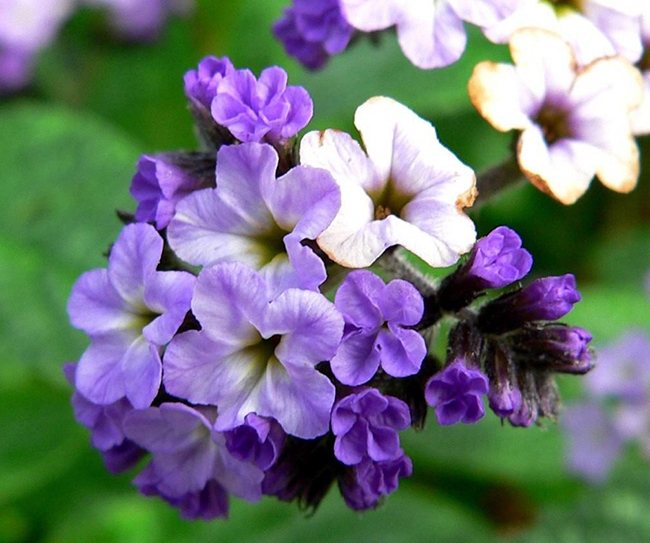

The whole genus of heliotropes has about 200-300 representatives, which naturally grow in the Mediterranean countries, South Asia and South America, as well as in some regions of Australia and even Russia. You can often find heliotrope in the form of a weed in the European part of Russia and the Caucasus.
Description of heliotrope:
- Heliotrope is a fragrant herb that grows in nature as a perennial and belongs to the same genus as forget-me-nots, lungwort, and cucumber herb.
- The plant grows in the form of a small branched bush, which in nature can reach a height of 2 m, and the culture grows only 50-60 cm.
- The stem is dense and highly branched, completely covered with oblong, pointed leaves.
- The leaves of the heliotrope are arranged alternately and are attached to the branches with the help of short petioles, have a slightly pubescent wavy or wrinkled surface. The upper leaf plate has a dark green tint, and the lower one is slightly lighter.
- At the very tops of the stems, beautiful inflorescences bloom, which can reach 10-15 cm in diameter.
- The flowers are very small, consist of 5 petals, very similar to lilac flowers. Collected in thyroid inflorescences.
- The color of heliotrope ranges from purple to deep blue and light blue.
- Heliotrope flowers contain a very aromatic and valuable essential oil that is used in cosmetology and perfumery. Often the planting of heliotrope flowers is carried out on an industrial scale.
- The inflorescences bloom for one month, after which a fruit appears in their place, which is a coenobium.
- After full maturation, the coenobium splits into 4 parts, which contain heliotrope seeds.
- Some types of heliotrope contain poisonous alkaloids in the stems and seeds, which have a detrimental effect on the human nervous system. However, these species are not used in culture.
- In 1552, botanical scientists for the first time isolated a coloring substance from heliotrope, which was later called litmus.Until now, all chemists use special litmus strips to determine the acidity of the medium.
- Heliotrope is a thermophilic plant, therefore in our climate it is used as an annual. You can also grow heliotrope at home. So it will grow over the course of several years.
